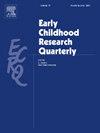早教中心的补贴密度:比较两个全国样本的中心和社区协会
IF 3.1
1区 教育学
Q1 EDUCATION & EDUCATIONAL RESEARCH
引用次数: 0
摘要
政府从儿童保育和发展基金发放的儿童保育补贴是在美国提供公平获得儿童保育和早期教育的机制。利用2012年全国早教调查(NSECE)和2019年全国早教调查(NSECE)两个全国性样本,我们评估了早教中心特征与补贴密度(即使用补贴的入学儿童比例)之间的关系。我们的研究结果表明,中心的特定特征——包括中心的招生、运营和财务结构——以及它们周围的社区——与补贴密度有关。在这两个样本中,招收婴儿或幼儿、拥有质量评级或营利性地位、在中等或高度贫困密度地区开展业务,以及接受父母工资,与使用补贴的儿童比例增加有关。有更多的儿童入学和完全入学与使用补贴入学的儿童比例下降有关。2019年样本的独特之处在于,接受学前教育和公共学前教育资金与使用补贴进入中心的儿童比例较高有关。考虑到接受补贴的中心数量的下降,以及有证据表明中心可能会限制补贴参与程度以维持运营,了解与补贴密度相关的项目特征对于制定支持符合补贴条件的儿童进入欧洲经委会的政策至关重要。本文章由计算机程序翻译,如有差异,请以英文原文为准。
Subsidy density in early education centers: Comparing center and community associations across two nationwide samples
Government-issued child care subsidies from the Child Care and Development Fund are a mechanism for providing equitable access to child care and early education in the United States. Using two nationwide samples, the 2012 National Survey of Early Care and Education (NSECE) and the 2019 NSECE, we assess the relationship between features of early care and education centers and subsidy density, or the proportion of children enrolled that use subsidies. Our findings suggest specific features of centers— including the center’s enrollment and operational and financial structure— as well as their surrounding communities, are associated with subsidy density. Across both samples, enrolling infants or toddlers, having a quality rating or for-profit status, operating in an area with moderate or high poverty density, and receiving parent pay are associated with increased proportions of children using subsidies. Having a higher number of children enrolled and being fully enrolled are linked with decreased proportions of children using subsidies enrolled. Unique to the 2019 sample, receiving Head Start and public pre-K funds are associated with a higher proportion of children using subsidies enrolled in centers. Given the documented decline of centers receiving subsidies and evidence that centers may limit the degree of subsidy participation to sustain operations, understanding features of programs associated with subsidy density is critical to creating policies that support ECE access for subsidy-eligible children.
求助全文
通过发布文献求助,成功后即可免费获取论文全文。
去求助
来源期刊

Early Childhood Research Quarterly
Multiple-
CiteScore
7.00
自引率
8.10%
发文量
109
期刊介绍:
For over twenty years, Early Childhood Research Quarterly (ECRQ) has influenced the field of early childhood education and development through the publication of empirical research that meets the highest standards of scholarly and practical significance. ECRQ publishes predominantly empirical research (quantitative or qualitative methods) on issues of interest to early childhood development, theory, and educational practice (Birth through 8 years of age). The journal also occasionally publishes practitioner and/or policy perspectives, book reviews, and significant reviews of research. As an applied journal, we are interested in work that has social, policy, and educational relevance and implications and work that strengthens links between research and practice.
 求助内容:
求助内容: 应助结果提醒方式:
应助结果提醒方式:


